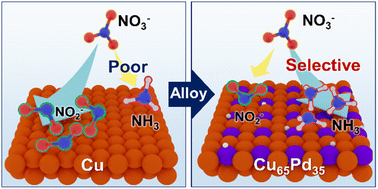Synergistic bimetallic CuPd oxide alloy electrocatalyst for ammonia production from the electrochemical nitrate reaction†
Abstract
The electrochemical nitrate reduction reaction (eNO3RRs) can produce value-added chemicals such as ammonia (NH3) via multiple steps. Here, we demonstrate that bimetallic Cu–Pd–Ox alloy electrocatalysts can promote selective NH3 production from the eNO3RR, especially at low overpotential, by accelerating the rate-determining hydrogenation of NO2−, a critical intermediate, on the Cu catalyst. The synergistic effect of Cu and Pd affords 14 times higher NH3 yield (1.41 mg h−1 cm−2) at −0.2 VRHE with an optimum composition (Cu0.65Pd0.35Ox) than that obtained using bare CuOx. The operando near edge X-ray absorption fine structure (NEXAFS) and simulation results support that the high hydrogen affinity of Pd facilitates sequential hydrogenation on metallic Cu active sites, consequently increasing the NH3 selectivity and production rate. Our study sheds light on the mechanism of the catalytic eNO3RR and presents a design strategy for more advanced eNO3RR electrocatalysts.



 Please wait while we load your content...
Please wait while we load your content...